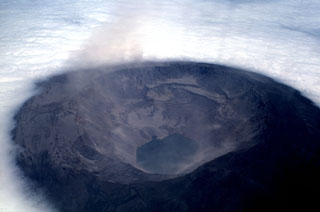Report on Fernandina (Ecuador) — March 1995
Bulletin of the Global Volcanism Network, vol. 20, no. 3 (March 1995)
Managing Editor: Richard Wunderman.
Fernandina (Ecuador) Lava enters the sea at three locations; ejections from lava lake
Please cite this report as:
Global Volcanism Program, 1995. Report on Fernandina (Ecuador) (Wunderman, R., ed.). Bulletin of the Global Volcanism Network, 20:3. Smithsonian Institution. https://doi.org/10.5479/si.GVP.BGVN199503-353010
Fernandina
Ecuador
0.37°S, 91.55°W; summit elev. 1476 m
All times are local (unless otherwise noted)
Fernandina continued to erupt in late March. While acting as a guide for a film crew, Godfrey Merlin made his third visit . . . and reported on 26 March concerning the 30 hours the group spent at the volcano.
Lava flowing into the sea was concentrated in three areas. Two areas were the same as two months earlier, and the third was ~400 m to the N. Most of the lava descended the near-vertical shoreline, a sea-cliff that was typically ~4-m high and being progressively undercut by wave action removing sand along its base. Flowing in channels of 0.5-1.5 m width, the lava often dripped into the ocean, although Merlin noted that the lava to the N had "the appearance of water cascading to the sea." Discolored water still surrounded the lava's ocean entries. The amount of lava flowing into the sea was difficult to judge, but at least one substantial fluctuation in flow volume was seen during their 30-hour visit.
The group reached shore at the Cape Hammond landing, an area rich in wildlife that could have been threatened if lava flows had continued to progress in that direction. They found that nearby flow fronts remained immobile since the previous visit . . . . Merlin suggested that the lava issuing from main vent (now a well-formed cone), was descending in old tubes to the shore. At night, no incandescence could be seen between the main vent and the sea. During the day, in the upper third of this interval, white vapor rose from the lava flows but otherwise there was little surface evidence of their freshness.
While hiking to the main vent they heard several explosions and saw molten lava "tossed above the rim of the cone every few seconds." Nevertheless, Merlin and Mr. Iwago of the Japanese Broadcasting Corporation (NGK) ascended the cone's base, which they described as built on "huge blocks of reddish-gray rock jumbled together" with intermediate spaces "filled with glassy scoria." Next, they descended into a shallow valley of scoria with extremely hot vents, some ringed by white deposits. They climbed the upper slopes of the spatter cone from the E, upwind side, and found that the cone held a "heaving, rolling, red sea of molten lava" that was ~30-40 m in diameter and 40 m below the cone's rim. Spatter was thrown ~70 m above the lava lake's surface. On the cone's W side, lava flowed over the rim and descended into a tube within the cone.
They found eight dead marine iguanas. Although their appearance ranged from unscorched to charred, the iguanas had each been "literally cooked on the surface of the lava." The group also noted that live iguanas continued to invade the still-hot surface. In contrast to earlier in the eruption, no dead fish were seen floating along the coast and accordingly the large number of sea birds that previously had come to feed on them were absent.
Geological Summary. Fernandina, the most active of Galápagos volcanoes and the one closest to the Galápagos mantle plume, is a basaltic shield volcano with a deep 5 x 6.5 km summit caldera. The volcano displays the classic "overturned soup bowl" profile of Galápagos shield volcanoes. Its caldera is elongated in a NW-SE direction and formed during several episodes of collapse. Circumferential fissures surround the caldera and were instrumental in growth of the volcano. Reporting has been poor in this uninhabited western end of the archipelago, and even a 1981 eruption was not witnessed at the time. In 1968 the caldera floor dropped 350 m following a major explosive eruption. Subsequent eruptions, mostly from vents located on or near the caldera boundary faults, have produced lava flows inside the caldera as well as those in 1995 that reached the coast from a SW-flank vent. Collapse of a nearly 1 km3 section of the east caldera wall during an eruption in 1988 produced a debris-avalanche deposit that covered much of the caldera floor and absorbed the caldera lake.
Information Contacts: G. Merlen, Estacion Cientifica Charles Darwin.

